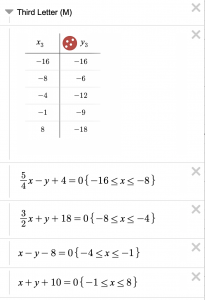This week in Math 10, we learnt how to solve word problems. Word problems can be tricky and it’s easy to ix up words. There are certain words that you have to pay close attention for since it can help structure the equations. Things to remember:
- Equals: other words for this can be; is, will, was, would be, cost, etc. That means that you need an equal sign.
- Switch words: switch words are where you might need to switch up the order of how the equation is. Examples of switch words would be: less than, more than, and from.
The word problem I’m showing to solve:
The length of a rectangle is five less than three times its width. If the perimeter is 38 inches, find the rectangles dimensions.
An important thing to remember is that you should always read it at least two times because the first time you should skim through it then re-read it the second but more carefully and highlight/circle the key words.
The length of a rectangle is five less than three times it width. If the perimeter is 38 inches, find the rectangles dimensions.\
The first sentence says that L equals 5 less than 3W. Since “less than” is a switch word, our equation would be L+3W-5
The second sentence says that the perimeter total is 38 inches which means the equation would be 2L+2W=38
L=3W-5
2L+2W=38
We can use substitution to find our variables since in the first equation we already have L by itself, so in the second equation we replace L.
2(3W-5)+2W=38 –> 6W-10+2W=38 –> 8W-10=38 –> 8W=38+10 –> 8W=48 –> 8W/8=48/8 –> W=6
Now that we have W, we can plug that into the first equation.
L=3(6)-5 –> L=18-5 –> L=13
Now since we have our L and W, we have to check it to make sure that we have the correct numbers.
L=3W-5 –> 13=3(6)-5 –> 13=18-5 –> 13=13
2L+2W=38 –> 2(13)+2(6)=38 –> 26+12=38 –> 38=38
It works! L=13, W=6
























